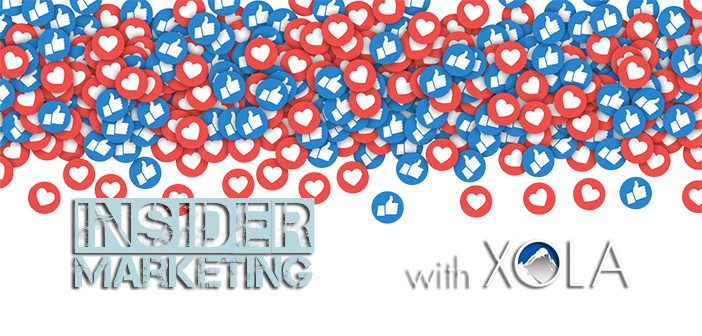This year, Facebook announced a major change to its News Feed algorithm, which makes it harder than ever for any business with a Facebook page—including aerial adventure parks—to reach fans organically on the social media network.
Facebook defines organic reach as, “the total number of unique people who were shown your post through unpaid distribution.” For a long time, organic reach was king. That’s why getting more Facebook users to “like” your brand page was so important. More page likes meant a larger audience for your posts, which led to successful campaigns—and you didn’t need to pay to get your content in front of them. It was a great time to be a marketer.
Now, that has all changed.
With the steep decline of organic reach on Facebook, the old strategies simply won’t work. If you want to be successful on Facebook, you have to invest in paid ads, or find a more creative way to reach your fans, encourage them to share, and generate new bookings (more on that later).
Organic Reach is (almost) Dead
In 2012, Facebook famously restricted organic reach so that the average unpaid post on a business page only reached 16 percent of fans. By 2014, organic reach dropped to about six percent.
In January 2018, Facebook CEO Mark Zuckerberg made a statement that put the final nail in the coffin: “We started making changes in this direction last year [2017] … The first changes you’ll see will be in News Feed, where you can expect to see more from your friends, family and groups. As we roll this out, you’ll see less public content like posts from businesses, brands, and media.”
With Facebook now prioritizing organic content from “friends, family and groups” over “businesses, brands, and media,” most marketers expect to reach as little as one percent of their fans by posting unpaid content on their page.
In short, organic posts on your business page will no longer reach an overwhelming majority of the people who like your page. A smaller audience means less exposure, leading to less awareness of what you have going on—at least on Facebook. It’s a tough pill to swallow.
However, it presents a new and exciting opportunity for aerial adventure industry marketers who are willing to reinvent their social media strategy.
Your Customers Are Your Best Marketers
Facebook’s new emphasis on prioritizing posts from “friends and family” means that reaching the fans of your Facebook page (without paying for it) is very challenging, which means that you can’t encourage them to share your content and attract new customers.
Luckily, your guests can.
Turning your guests into advocates that share, refer, and promote your business has always been a winning strategy.
According to Nielsen’s Global Trust in Advertising report, 92 percent of consumers around the world say they trust earned media, such as social media and recommendation from friends and family, above all forms of advertising.
With the demise of organic reach on Facebook, zip lines and aerial adventure parks would be wise to focus their social media resources on a viral strategy that harnesses the reach of their guests, instead of building an audience on their Facebook page.
Here are two simple ways to increase awareness and get free bookings by turning your guests into your best marketers.
- Sell Shareable Photos and Videos
More and more zip line and aerial adventure park operators are utilizing photo systems and software to capture and sell photos and videos to guests. And for good reason.
According to Adventure Park Insider’s 2018 State of the Industry Report:
“In the past year [2017], the number of operations with photo services has increased by 15 percentage points; more than half of our responding [pay to play]operators now offer photo services. These services account for an average of 8% of overall revenues, but can be as much as 25% of total revenue.”
Eight percent of revenue from photo sales is impressive, but that isn’t the whole story. Photo and video services don’t just increase revenue—they can also be a powerful social media tool that can increase your reach and help attract new customers.
There are a variety of photo and video systems that also act as sales and marketing tools. Many of the systems not only capture the photos of guests on course, but also emblazon the images with a park’s brand and make it easy for guests to share them on social media. The options vary per system, but most allow guests to purchase photos either on-site or through a unique website URL guests can visit after their trip. Of course, there’s revenue potential in photo sales, but it can be argued that the value of branded photos being shared on social media by guests is an equally, if not more, valuable feature of these systems.
- Post Group Photos on Your Business Page
In 2014, “escape rooms” hit North America by storm. This new kind of teambuilding activity “locks” participants in a room, and they must work together to find clues and solve puzzles in order to escape (usually within 30 to 60 minutes).
It has become wildly popular. In 2014, there were only 22 escape rooms in the U.S. Now there are more than 1,800—and the number continues to grow.
The key to the industry’s impressive growth is its use of social amplification. Social amplification is the art of getting your social content (such as Facebook posts, photos, and videos) shared by others on social media. In turn, the shared content can increase the number of bookings an operator receives through word-of-mouth.
The way escape rooms do this is simple. After every game, they get the group together for a photo. Staff will give group members props and funny signs to make photo more fun and interesting. The photo is then uploaded to Facebook and Instagram, and customers are invited to tag themselves and share the photo on social media.
Aerial adventure operators can and should adopt a similar strategy. It’s an easy way to increase organic reach, gain more exposure, and hopefully boost bookings. Get creative with it and take cool photos that guests will actually want to tag themselves in and share on social media. A standard group shot won’t get as much love as a fun, interesting, and unique group shot will. Choose a cool background, encourage silly poses, etc.
Group photos are much better for sharing because they have a certain “amplification effect.”
Often one of the more socially active members of the group will take it on him- or herself to tag the group members and share the photo for the first time. This encourages more “socially shy” guests to share the photo, too. The cycle continues, and the photo promoting your park spreads throughout the social web, gaining free exposure to the group’s friends and family.
With organic reach on Facebook shrinking, marketers can’t rely on the same “post and pray” tactics that worked so well in the past. Instead, marketers need to consider new ways to access customers on social media.






